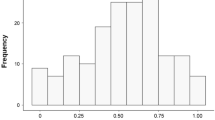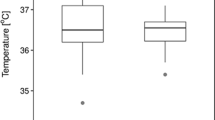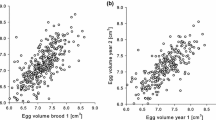Summary
We studied the relative contribution of each sex and total effort expended in feeding nestlings in the great tit Parus major in relation to artificially altered brood size. A recent model suggests that feeding frequency should reflect the optimal trade-off between parental and fledgling survival, the former being negatively, the latter positively, influenced by high feeding frequencies. In both sexes weight loss was linearly related to feeding frequency. Since fledgling survival increases with nestling weight, the conditions of this model are fulfilled. However, in contrast to the predictions of the model, the total feeding frequency for both sexes combined did not differ between control and enlarged broods, but was lower for reduced ones. This outcome was not the result of a physiologically related inability of the parents to increase their delivery rate. Instead, we suggest that parents with enlarged broods could not find sufficient amounts of prey large enough to be economically worth transporting to the nest. Differences in brood-provisioning rates between the sexes may arise because costs and benefits of feeding nestlings may differ. Females lost more weight than males during the nesting period, but maintained a relatively higher weight during the incubation period. The relationship between weight loss and feeding frequency was similar for both sexes. Male and female brood-feeding frequency was related to brood size in a similar way. This is discussed in light of the great tit's mating system and the fact that the great tit is facultatively double-brooded.
Similar content being viewed by others
References
Alatalo RV, Gottlander K, Lundberg A (1988) Conflict or cooperation between parents in feeding nestlings in the pied flycatcher Ficedula hypoleuca. Ornis Scand 19:31–34
Askenmo C (1977) Effects of addition and removal of nestlings on nestling weight, nestling survival, and female weight loss in the pied flycatcher Ficedula hypoleuca. Ornis Scand 8:1–8
Balen JH van (1973) A comparative study of the breeding ecology of the great tit Parus major in different habitats. Ardea 61:1–93
Biermann GC, Sealy SG (1982) Parental feeding of nestling yellow warblers in relation to brood size and prey availability. Auk 99:332–341
Björklund M, Westman B (1986) Mate-guarding in the great tit: tactics of a territorial forest-living species. Ornis Scand 17:99–105
Breitwisch R, Merritt PG, Whitesides GH (1986) Parental investment by the northern mockingbird: male and female roles in feeding nestlings. Auk 103:152–159
Bryant DM (1979) Reproductive cost in the house martin Delichon urbica. J Anim Ecol 48:655–675
De Steven D (1980) Clutch size, breeding success, and parental survival in the tree swallow (Iridoprocne bicolor). Evolution 34:278–291
Drent RH, Daan S (1980) The prudent parent: energetic adjustments in avian breeding. Ardea 68:225–252
Freed LA (1981) Loss of mass in breeding wrens: stress or adaptation? Ecology 62:1179–1186
Gibb JA (1950) The breeding biology of the great and blue titmice. Ibis 92:507–539
Gibb JA (1955) Feeding rates of great tits. Br Birds 48:49–58
Gibb JA, Betts MM (1963) Food and food supply of nestling tits (Paridae) in Breckland pine. J Anim Ecol 32:489–533
Gosler AG (1987) Pattern and process in the bill morphology of the great tit Parus major. Ibis 129:451–476
Greenlaw JS, Post W (1985) Evolution of monogamy in seaside sparrows, Ammodramus maritimus: tests of hypotheses. Anim Behav 33:373–383
Grundel R (1987) Determinants of nestling feeding rates and parental investment in the mountain chickadee. Condor 89:319–328
Haartman L von (1954) Der Trauerfliegenschnäpper. III. Die Nahrungsbiologie. Acta Zool Fenn 83:1–96
Högstedt G (1980) Evolution of clutch size in birds: adaptive variation in relation to territorial quality. Science 210:1148–1150
Houston AI (1987) Optimal foraging by parent birds feeding dependent young. J Theor Biol 124:251–274
Houston AI, Davies NB (1985) The evolution of cooperation and life history in the dunnock Prunella modularis. In: Sibly RM, Smith RH (eds) Behavioural ecology: ecological consequences of adaptive behaviour. Blackwell, Oxford, pp 471–487
Hughes AL, Hughes MK (1986) Paternal investment and sexual size dimorphism in North American passerines. Oikos 46:171–175
Hussell DJT (1972) Factors affecting clutch size in arctic passerines. Ecol Monogr 42:317–364
Jones G (1987) Parent-offspring allocation in swallows during nestling rearing: an experimental study. Ardea 75:145–168
Klomp H (1970) The determination of clutch-size in birds: a review. Ardea 58:1–124
Kluijver HN (1951) The population ecology of the great tit, Parus m. major L. Ardea 39:1–135
Lack D (1947) Thesignificance of clutch-size. Ibis 89:302–352
Lack D (1954) The natural regulation of animal numbers. Clarendon, Oxford
Leffelaar D, Robertson RJ (1986) Equality of feeding roles and the maintenance of monogamy in tree swallows. Behav Ecol Sociobiol 18:199–206
Lifjeld JT (1988) Prey choice and nestling hunger:an experiment with pied flycatchers, Ficedula hypoleuca. Anim Behav 36:134–139
Lima SL (1987) Clutch size in birds: a predation perspective. Ecology 68:1062–1070
Lyon BE Montgomerie RD, Hamilton LD (1987) Male parental care and monogamy in snow buntings. Behav Ecol Sociobiol 20:377–382
Maynard Smith J (1977) Parental investment: a prospective analysis. Anim Behav 25:1–9
Norberg RÅ (1981) Temporary weight decrease in breeding birds may result in more fledged young. Am Nat 118:838–850
Nur N (1984a) The consequences of brood size for breedin blue tits I. Adult survival, weight change and the cost of reproduction. J AnimEcol 53:479–496
Nur N (1984b) Feeding frequencies of nestling blue tits (Parus caeruleus): costs, benefits and a model of optimal feeding frequency. Oecologia (Berlin) 65:125–137
Nur N (1987) Parents, nestlings and feeding frequency: a model of optimal parental investment and implications for avian reproductive strategies. In: Kamil A, Krebs JR, Pulliam HR (eds) Foraging behavior. Plenum New York
Orians GH, Pearson NE (1979) On the theory of central place foraging. In: Horn DJ, Stairs BR, Mitchell RD (eds) Analysis of ecological systems. Ohio State Univ Press Columbus, pp 155–177
Perrins CM (1965) Population fluctuation and clutch-size in the great tit Parus major L.. J Anim Ecol 34:601–647
Perrins CM (1979) British tits. Collins, London
Perrins CM, Moss D (1975) Reproductive rates in the great tit. J Anim Ecol 44:695–706
Regelmann K, Curio E (1986) Why do great tit (Parus major) males defend their brood more than females do? Anim Behav 34:1206–1214
Royama T (1966) Factors governing feeding rate, food requirement and brood size of nestling great tits Parus major Ibis 108:313–347
Rutberg AT, Rohwer S (1980) Breeding strategies of male yellow-headed blackbirds: results of a removal experiment. Auk 97:619–622
Sasvari L (1986) Reproductive effort of widowed birds J Anim Ecol 55:553–564
Schoener TW (1979) Generality of the size-distance relation in models of optimal feeding. Am Nat 114:902–914
Searcy WA (1979) Sexual selection and body size in male redwinged blackbirds. Evolution 33:649–661
Smith JNM (1978) Division of labour by song sparrows feeding fledged young. Can J Zool 56:187–191
Smith JNM, Tom-Tov Y, Moses R (1982) Polygyny, male parental care, and sex ratio in song sparrows: an experimental study. Auk 99:555–564
Smith HG, Källander H, Nilsson JÅ (1987) Effect of experimentally altered brood size on frequency and timing of second clutches in the great tit. Auk 104:700–706
Sokal RR, Rohlf FJ (1981) Biometry. Freeman, San Francisco
Tinbergen JM (1981) Foraging decisions in starlings (Sturnus vulgaris). Ardea 69:1–67
Trivers RL (1972) Parental investment and sexual selection. In: Campell B (ed) Sexual selection and the descent of man. Heinemann, London, pp 136–179
Weatherhead PJ (1979) Ecological correlates of monogamy in tundra-breeding savannah sparrows. Auk 96:391–401
Westerterp K, Gortmaker W, Wijngaarden H (1982) An energetic optimum in brood-raising in the starling Sturnus vulgaris: an experimental study. Ardea 70:153–162
Author information
Authors and Affiliations
Rights and permissions
About this article
Cite this article
Smith, H.G., Källander, H., Fontell, K. et al. Feeding frequency and parental division of labour in the double-brooded great tit Parus major . Behav Ecol Sociobiol 22, 447–453 (1988). https://doi.org/10.1007/BF00294983
Received:
Accepted:
Issue Date:
DOI: https://doi.org/10.1007/BF00294983




